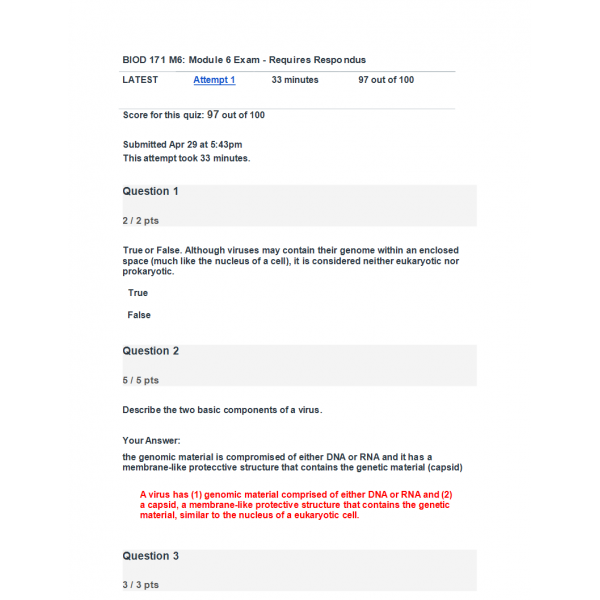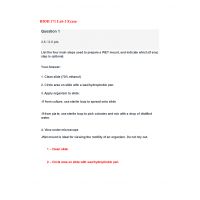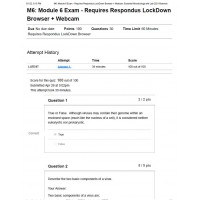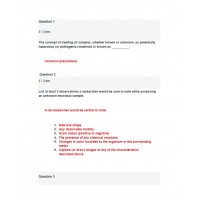BIOD 171 M6: Module 6 Exam - Requires Respondus LockDown Browser + Webcam
97 out of 100
1. True or False. Although viruses may contain their genome within an enclosed space (much like the nucleus of a cell), it is considered neither eukaryotic nor prokaryotic.
2. Describe the two basic components of a virus.
3. True or False. You would expect to see a viral envelope on a virus infecting a plant cell.
4. Rank the following viruses based on their size from largest to smallest:
5. True or False: Viral replication occurs after it attaches and enters the host cell.
6. Place the following viral life cycle steps in order beginning with viral attachment and provide a description of each step.
7. New infection:
8. A virus that infects bacteria is called a [answer1] and contains a [answer2] -sided polygon capsid.
9. True or False. Structurally, bacteriophages are distinct from viruses that infect plant or animal cells.
10. Identify the following components of a bacteriophage.
11. Describe the main differences between lytic and temperate phages.
12. Based on the following image, would you expect the viral titer to be high or low? Why?
13. Which of the following can be spread via airborne particles:
14. Measles, mumps and rubella can all be spread via airborne particles formed while coughing, sneezing, etc.
15. True or False. A patient infected with rubella is only considered infectious when the trademark rash is visible.
16. A patient diagnosed with German measles may additionally experience what disease? Select all that apply.
17. Which of the following diseases does a linear, single-stranded RNA virus cause?
18. Measles, mumps and rubella are all linear, single-stranded RNA viruses.
19. What disease displays as a secondary characteristic swelling of the testes/ovaries and pancreas?
20. Describe two ways chickenpox can be spread.
21. True or False. Someone who had chickenpox as a child is likely to develop shingles while in college, where the median age of college students is 18-22 years old.
22. True or False. Similar to chickenpox, the blisters that appear with shingles can cover the entire body.
23. A person who has neither previously had chickenpox nor been administered the VZV vaccine is exposed to someone with an active VZV (shingles) outbreak and becomes infected. Explain why (or why not) the person will only develop shingles.
24. While traveling abroad, should you be worried about coming into contact with either the Variola major or Variola minor viruses?
25. What small (~30nm) single-stranded, non-enveloped RNA virus causes temporary or permanent paralysis by infiltrating (infecting) motor neurons within the spinal cord, brain stem, or motor cortex?
26. By whom and where was the first polio vaccine developed?
27. Which subtype of Influenza is the most virulent?
28. A drug company is trying to develop a new drug that will inhibit the release of newly produced viral particles. Would the drug company target hemagglutinin proteins or neuraminidase proteins? Why?
29. Explain why the flu shot given each year may not be 100% effective at preventing the flu?
28. True or False. The viral capsid of HIV is cone shaped and contains ~2,000 copies of the viral protein p24.
29. The HIV surface glycoprotein gp41 binds what host cellular receptor?
30. An individual infected with HIV is placed on anti-retroviral medication. What is the general purpose of this medication?
| Institution & Term/Date | |
| Term/Date | Portage Learning |
BIOD 171 Module 6 Exam
- Product Code: 2022
- Availability: In Stock
-
$19.99
Related Products
BIOD 171 Lab 3 Exam
$19.99
BIOD 171 M6 Module 6 Exam
$19.99
BIOD 171 M6 Module 6 Review
$19.99
BIOD 171 Module 4 Exam
$19.99
BIOD 171 Module 5 Exam
$19.99








-200x200.JPG)